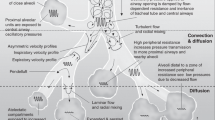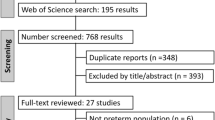Abstract
OBJECTIVE: To compare pressure support ventilation (PSV) with volume guarantee (VG) to synchronized intermittent mandatory ventilation (SIMV) in infants with respiratory distress syndrome (RDS).
STUDY DESIGN: A randomized, crossover study design was used. We enrolled 14 infants [BW (mean±SD) 2.5±0.7 kg, GA 34±2 weeks, age 49±26 hours]. Subjects received 4 hours of each mode of ventilation, with the first mode selected randomly. End expiratory volume (EEV) was measured during both ventilatory modes.
RESULTS: Minute ventilation was greater with PSV+VG than with SIMV (p=0.012). This occurred despite no difference in paCO2. Mean airway pressure was higher during PSV+VG (p=0.023). There was no difference in the arterial/alveolar oxygen tension (a/A) ratio or in the specific dynamic compliance (sCdyn).
CONCLUSION: Because of an increase in VE with PSV+VG, and no difference in the a/A ratio or sCdyn, we do not recommend the routine use of PSV+VG for this population.
This is a preview of subscription content, access via your institution
Access options
Subscribe to this journal
Receive 12 print issues and online access
$259.00 per year
only $21.58 per issue
Buy this article
- Purchase on Springer Link
- Instant access to full article PDF
Prices may be subject to local taxes which are calculated during checkout






Similar content being viewed by others
References
Dimitriou G, Greenough A, Giffin F, Chan V . Synchronous intermittent mandatory ventilation modes compared with patient-triggered ventilation during weaning Arch Dis Child 1995 72: F188–90
Carlton DP, Cummings JJ, Scheerer RG . Lung over expansion increases pulmonary microvascular protein permeability in young lambs J Appl Physiol 1990 69: 577–83
Tsuno K, Minura K, Takeya M . Histopathologic pulmonary changes from mechanical ventilation at high peak airway pressure Am Rev Respir Dis 1991 143: 1115–20
Dreyfuss D, Saumon G . Role of tidal volume, FRC, and end-inspiratory volume in the development of pulmonary edema following mechanical ventilation Am Rev Respir Dis 1993 148: 1194–203
Herrera CM, Gerhardt T, Everett R, Claure N, Musante G, Bancalari E . Randomized, crossover study of volume guarantee versus synchronized intermittent mandatory ventilation in very low birth weight infants recovering from respiratory failure Pediatr Res 1999 45: 304 (Abstract)
Keszler M, Abubakar KM . Volume targeted mechanical ventilation of newborns maintains more stable tidal volume but does not prevent hypocarbia in the first 24 hours of life Pediatr Res 1999 45: 307A (Abstract)
Herrera CM, Gerhardt T, Everett R, Claure N, Thomas C, Bancalari E . Volume guarantee ventilation with two different tidal volumes versus synchronized intermittent mandatory ventilation in very low birth weight infants. A randomized crossover study Pediatr Res 2000 47: 361A (Abstract)
Mrozek JD, Bendel-Stenzel EM, Meyers PA, Bing DR, Connett JE, Mammel MC . Randomized controlled trial of volume-targeted synchronized ventilation and conventional intermittent mandatory ventilation following initial exogenous surfactant therapy Pediatr Pulmonol 2000 29: 11–8
Krauss AN, Auld PAM . Measurement of functional residual capacity in distressed neonates by helium rebreathing J Pediatr 1970 77: 228–32
Da Silva WJ, Abbasi S, Pereira G, Bhutani VK . Role of positive end-expiratory pressure changes on functional residual capacity in surfactant treated preterm infants Pediatr Pulmonol 1994 18: 89–92
Davis JM, Veness-Meeham K, Notter RH, Bhutani VK, Kendig JW, Shapiro DL . Changes in pulmonary mechanics after administration of surfactant to infants with respiratory distress syndrome N Engl J Med 1988 319: 476–9
Goldsmith LS, Greenspan JS, Rubenstein D, Wolfson MR, Shaffer TH . Immediate improvement in lung volume after exogenous surfactant: alveolar recruitment versus increased distension J Pediatr 1991 119: 424–8
Dimitriou G, Greenough A, Kavadia V . Changes in lung volume, compliance and oxygenation in the first 48 hours of life in infants given surfactant J Perinat Med 1997 25: 49–54
Fox WW, Schwartz JG, Shaffer TH . Effects of endotracheal tube leaks on functional residual capacity determination in intubated neonates Pediatr Res 1979 13: 60–4
Richardson P, Wyman ML, Jung AL . Functional residual capacity and severity of respiratory distress syndrome in infants Crit Care Med 1980 8: 637–40
Kavvadia V, Greenough A, Dimitrious G . Prediction of extubation failure in preterm neonates Eur J Pediatr 2000 159: 227–31
Kavvadia V, Greenough A, Dimitrious G . Early prediction of chronic oxygen dependency by lung function test results Pediatr Pulmonol 2000 29: 19–26
Hotchkiss JR Jr, Adams AB, Stone MK, Dries DJ, Marini JJ, Crooke PS . Oscillations and noise. Inherent instability of pressure support ventilation? Am J Respir Crit Care Med 2002 165: 47–53
Boker A, Graham MR, Walley KR et al. Improved arterial oxygenation with biologically variable or fractal ventilation using low tidal volumes in a porcine model of acute respiratory distress syndrome Am J Respir Crit Care Med 2002 165: 456–62
Acknowledgements
We acknowledge the assistance in statistical analysis offered by Stephen Simon, PhD, Children's Mercy Hospitals and Clinics, University of Missouri-Kansas City School of Medicine (Kansas City, MO). Supported by Children's Mercy Hospital Research and Education Award (S. L. O.), Children's Mercy Hospital Physician Scientist Award (W. E. T.), and computer software upgrade support from Drager.
Author information
Authors and Affiliations
Additional information
This work was presented at Pediatric Academic Societies Meeting, Baltimore, MD, 2001.
Rights and permissions
About this article
Cite this article
Olsen, S., Thibeault, D. & Truog, W. Crossover Trial Comparing Pressure Support With Synchronized Intermittent Mandatory Ventilation. J Perinatol 22, 461–466 (2002). https://doi.org/10.1038/sj.jp.7210772
Published:
Issue Date:
DOI: https://doi.org/10.1038/sj.jp.7210772
This article is cited by
-
State of the art in conventional mechanical ventilation
Journal of Perinatology (2009)
-
Is there an Advantage of Using Pressure Support Ventilation with Volume Guarantee in the Initial Management of Premature Infants with Respiratory Distress Syndrome? A pilot study
Journal of Perinatology (2005)
-
A Crossover Analysis of Mandatory Minute Ventilation Compared to Synchronized Intermittent Mandatory Ventilation in Neonates
Journal of Perinatology (2005)
-
Response to Olsen, et al. study comparing SIMV & PSV
Journal of Perinatology (2003)
-
Pre-ECMO Predictors of Nonsurvival in Congenital Diaphragmatic Hernia
Journal of Perinatology (2002)



